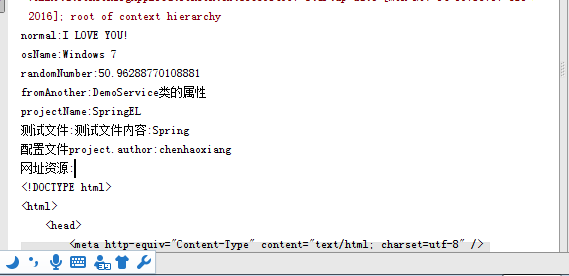【Spring】Spring常用配置-Spring EL和資源呼叫
阿新 • • 發佈:2019-02-08
分析
先簡單介紹下Spring EL。
Spring EL 也就是Spring表示式語言,支援在xml和註解中使用表示式,類似於JSP的EL表示式語言。
Spring開發中我們可能經常涉及到呼叫各種資源的情況,包含普通檔案、網址、配置檔案、系統環境變數等,我們可以使用Spring的表示式語言實現資源的注入。
Spring主要在註解@Value的引數中使用表示式。
本示例演示實現以下幾種情況:
1、注入普通的字串
2、注入作業系統屬性
3、注入表示式運算結果
4、注入其他Bean的屬性
5、注入檔案內容
6、注入網址內容
7、注入屬性檔案
示例
因為需要將file轉換成字串,我們增加commons-io可以簡化檔案的相關操作、
在pom檔案中增加如下程式碼:
<!--簡化檔案操作-commons-io-->
<dependency>
<groupId>commons-io</groupId>
<artifactId>commons-io</artifactId>
<version>2.4</version>
</dependency>然後,在當前類的目錄下新建test.txt。內容隨意。
我的內容如下:
測試檔案內容:Spring 然後再新建test.properties檔案,內容如下,當然,你也可以自己修改:
project.name=SpringEL
project.author=chenhaoxiang寫需要被注入的Bean:
package cn.hncu.p2_2_2SpringEL;
import org.springframework.beans.factory.annotation.Value;
import org.springframework.stereotype.Service;
/**
* Created with IntelliJ IDEA.
* User: 陳浩翔.
* Date: 2016/11/13.
* Time: 下午 9:06.
* Explain:被注入的Bean
*/ 增加配置類:
package cn.hncu.p2_2_2SpringEL;
import org.apache.commons.io.IOUtils;
import org.springframework.beans.factory.annotation.Autowired;
import org.springframework.beans.factory.annotation.Value;
import org.springframework.context.annotation.Bean;
import org.springframework.context.annotation.ComponentScan;
import org.springframework.context.annotation.Configuration;
import org.springframework.context.annotation.PropertySource;
import org.springframework.context.support.PropertySourcesPlaceholderConfigurer;
import org.springframework.core.env.Environment;
import org.springframework.core.io.Resource;
import java.io.IOException;
/**
* Created with IntelliJ IDEA.
* User: 陳浩翔.
* Date: 2016/11/13.
* Time: 下午 9:11.
* Explain:配置類
*/
@Configuration
@ComponentScan("cn.hncu.p2_2_2SpringEL")
@PropertySource("classpath:cn/hncu/p2_2_2SpringEL/test.properties")
public class ElConfig {
@Value("I LOVE YOU!")//注入字串
private String normal;
@Value("#{systemProperties['os.name']}")//獲取作業系統名
private String osName;
@Value("#{ T(java.lang.Math).random() * 100.0 }")//注入表示式結果
private double randomNumber;
@Value("#{demoService.another}")//注入其他Bean的屬性
private String fromAnother;
@Value("${project.name}")//注入配置檔案
private String projectName;
@Value("classpath:cn/hncu/p2_2_2SpringEL/test.txt")
private Resource testFile;//注意這個Resource是:org.springframework.core.io.Resource;
@Autowired //注入配置檔案
private Environment environment;
@Value("http://www.chaojijuhui.com")//注入網址資源
private Resource testUrl;
@Bean //注入配置檔案
public static PropertySourcesPlaceholderConfigurer propertyConfigurer(){
return new PropertySourcesPlaceholderConfigurer();
}
public void outputResource(){
try {
System.out.println("normal:"+normal);
System.out.println("osName:"+osName);
System.out.println("randomNumber:"+randomNumber);
System.out.println("fromAnother:"+fromAnother);
System.out.println("projectName:"+projectName);
System.out.println("測試檔案:"+IOUtils.toString(testFile.getInputStream()));
System.out.println("配置檔案project.author:"+environment.getProperty("project.author"));
System.out.println("網址資源:"+IOUtils.toString(testUrl.getInputStream()));
} catch (IOException e) {
e.printStackTrace();
}
}
}注入配置配件需要使用@PropertySource指定檔案地址,若使用@Value注入,則要配置一個PropertySourcesPlaceholderConfigurer的Bean。
注意,@Value(“${project.name}”)使用的是”$“而不是”#”。
上面的類演示了這2中配置配件的方式!
執行類:
package cn.hncu.p2_2_2SpringEL;
import org.springframework.context.annotation.AnnotationConfigApplicationContext;
/**
* Created with IntelliJ IDEA.
* User: 陳浩翔.
* Date: 2016/11/13.
* Time: 下午 11:44.
* Explain:執行類
*/
public class Main {
public static void main(String[] args) {
AnnotationConfigApplicationContext context = new AnnotationConfigApplicationContext(ElConfig.class);
ElConfig resourceService = context.getBean(ElConfig.class);
resourceService.outputResource();
context.close();
}
}
執行結果:
本文章由[諳憶]編寫, 所有權利保留。

